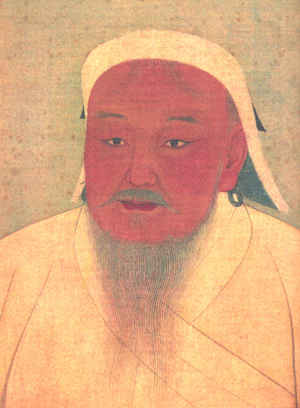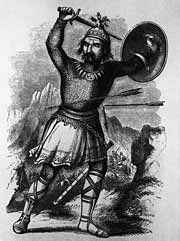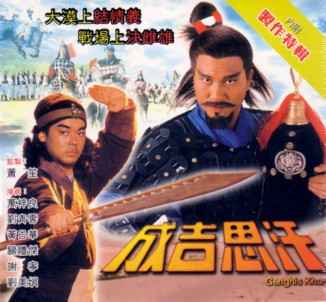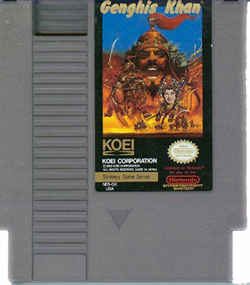|
Genghis Khanaka Jenghiz Khan, Cheng-chi-ssu-han, Temujin Genghis Khan conquered more land than anyone in human history, but could never shake the bad reputation that usually accompanies the words "Mongol horde".
Genghis Khan conquered more land than anyone in human history, but could never shake the bad reputation that usually accompanies the words "Mongol horde". Khan's actual name was Temujin, since it would have been presumptuous to name him "Supreme Ruler" (which is what "Genghis Khan" means) at birth. Temujin was born in the '60s... the 1160s, specifically, when free love and rock-n-roll were sweeping Mongol culture. The Mongols were a nomadic tribe with a Shamanic religious tradition, which in the minds of Europeans of the day equated to barbarism. Temujin certainly had a fairly barbaric upbringing. His father was killed by a rival tribe when he was barely a teenager. The young Mongol and his family spent his Wonder Years first in exile, where they starved and froze concurrently, then as a prisoner of a rival tribe. When he reached a not-so-tender age, Temujin killed his way to freedom for himself and his family. Killing would prove a very effective way for young Temujin to get what he wanted. Due to his prowess as a warrior, he eventually gained control of his late father's tribe, then set about building alliances. A rival tribe kidnapped his wife, prompting Temujin to mount a daring rescue attempt. His victory was so decisive that it inspired other tribes to pledge him their loyalty. After forging a loose federation through a mixture of conquest, intimidation and diplomacy, Temujin held an increasingly strong position as the 12th century came to a close. He invested the spoils of his wars into superior weaponry, including innovative siege machinery and armor for his cavalry, which gave him a decided advantage over his less-organized, more-impoverished rivals. His forces were extremely mobile; the cavalry carried spare horses so that riders forced to dismount could quickly regain their advantage.
His neighbors had reason to worry. Khan was a brilliant military strategist, and he pioneered several strategies which are now entirely entrenched in military warfare, including military intelligence and psyops. The Mongol horde was ruthless and efficient, and news of its approach inspired genuine "shock and awe" among those in its path. Khan swept over most of Central Asia. He captured Beijing and conquered China, the Korean peninsula and a big chunk of Russia. Khan's forces were highly trained, but they preferred not to fight. Khan employed overwhelming force and siege tactics to get what he wanted. When forced to fight, Khan's forces methodically slaughtered everyone in their path, a more effective terror tactic than some of the overly elaborate tortures employed by his rivals. Fairly or unfairly, the Mongol horde quickly gained a reputation for massacre, which had a tendency to shorten the sieges. Until very recently, most accounts of Mongol devastation included the wanton slaughter of civilians and prisoners.
We live in an age of revisionist histories, however, and the history of Genghis Khan is particularly susceptible. During the heyday of the Soviet Union, Mongolia lived under a despotic Communist regime that suppressed and tinkered heavily with the region's history. The topic of Genghis Khan, an icon of nationalistic pride, was verboten. What few tales survived were cast in a decidedly barbaric light. Khan's reputation was further sullied by association with the atrocities committed by his successors (like the grandson who built a pyramid out of the skulls of thousands of Baghdad's greatest scholars). In recent years, however, it has become fashionable to depict G.K. as a wise leader and philosopher, and not without reason. Although the process of being overcome by a Mongol horde was not especially pleasant, the actual Mongol regime wasn't bad once it was in place. Khan consolidated his rule by employing cooperative local officials from the previous regime and maintaining the local infrastructure largely intact. Khan also enforced a legal code that was surprisingly liberal for its day. In many respects, the Great Yasa closely mirrored the 10 Commandments and the Golden Rule, with an abiding precept being simply "Love one another". Khan also offered a "New Deal" that took care of the poor and infirm. Khan outlawed taxes on clerics of any religion. More controversial and progressive, for the day, Khan decreed that all children were legitimate, and thus entitled to inherit, even the children of prostitutes and concubines.
The legal code—known as the "Great Yasa"—forbade the ritual slaughter of animals, which meant that Muslims couldn't prepare halal meals in accordance with religious law. The Yasa also banned the designation of anything as taboo or unclean, which presented further problems. Khan also allowed women to be educated, banned efforts to make women cover their heads and encouraged freedom of expression and worship. As a result, numerous fatwas were issued against the hated Mongols, and the destruction of the Muslim caliphate by the Mongols (after the death of Khan) continues to shape the world's political landscape. All this alleged enlightenment aside, Genghis Khan had subjugated most of China and a fair amount of adjacent territory by the time he died at age 60—one year for every million people killed, give or take. The circumstances of the Great Khan's death are unknown. Most versions of the story hold that Khan fell from his horse and was killed. According to some legends, the fall took place during a hunt; others say it happened in the heat of battle. The burial of Genghis Khan was nearly as much of a production as his life. The exact site of his grave is one of history's most closely guarded secrets. Although a site in China is purported to be Khan's mausoleum, its authenticity is highly suspect. A more recently uncovered site on the steppes of Mongolia is still being investigated.
Khan's empire lived on after his death, initially parceled into four khanates divided among four sons of Temujin. Khan's successors continued his campaign of conquest for several generations. At its peak, the Mongolian Empire Temujin had founded was mind-blowing in scope, stretching from Poland to China along its northern border, and from Baghdad to Hanoi along its southern rim. Genghis Khan may be gone, but not forgotten. With literally hundreds of wives and concubines, not to mention who knows how many pieces on the side, Khan did his part to help repopulate Asia after depopulating it so memorably. To exploit... uh, we mean celebrate... this legacy, a Mongolian restaurant in London offered free DNA tests for male customers who want to know if they're descended from G.K. The restaurant offers free dinners to the Great One's progeny. It could end up being an expensive promotion. Given the amount of time that has passed, and Khan's profligate semen, it's estimated there could be as many as 17 million descendants alive today. And yet, somehow, it still seems special.
|
 In 1206, Temujin formally united the factions under his umbrella and declared himself Genghis Khan, "supreme ruler" of Mongolia. His power consolidated, Khan looked outward toward his neighbors.
In 1206, Temujin formally united the factions under his umbrella and declared himself Genghis Khan, "supreme ruler" of Mongolia. His power consolidated, Khan looked outward toward his neighbors.  It's difficult to know exactly how well-deserved that bad reputation was, but the Mongol Wars of the 13th century depopulated Asia by somewhere between 30 million and 60 million people. Hundreds of thousands of Chinese were said to have committed suicide in the face of approaching Mongol hordes.
It's difficult to know exactly how well-deserved that bad reputation was, but the Mongol Wars of the 13th century depopulated Asia by somewhere between 30 million and 60 million people. Hundreds of thousands of Chinese were said to have committed suicide in the face of approaching Mongol hordes.  Although Khan himself was not religious, his laws forbade overt religious or racial persecution, an extremely smart move for someone whose dynasty covered a vast melting pot of beliefs. The key word, however, was "overt." Despite his reputation for religious tolerance, many of Khan's supposedly non-denominational laws nevertheless amounted to persecution for different religions, particularly
Although Khan himself was not religious, his laws forbade overt religious or racial persecution, an extremely smart move for someone whose dynasty covered a vast melting pot of beliefs. The key word, however, was "overt." Despite his reputation for religious tolerance, many of Khan's supposedly non-denominational laws nevertheless amounted to persecution for different religions, particularly  According to legend, an armed escort accompanied Khan's body to its final resting place, slaying any living thing that witnessed their passage. One story says that Khan was buried alongside 40 baby camels. Other legends say the mystery has a more mundane cause—the funeral procession got mired on a muddy road and simply buried their illustrious leader on the spot.
According to legend, an armed escort accompanied Khan's body to its final resting place, slaying any living thing that witnessed their passage. One story says that Khan was buried alongside 40 baby camels. Other legends say the mystery has a more mundane cause—the funeral procession got mired on a muddy road and simply buried their illustrious leader on the spot. 